Betting on Blockbusters at the LMGI Awards: Do Big Budgets Mean Better Locations?

In the high-stakes world of filmmaking, a blockbuster budget can unlock the globe, allowing productions to transform the world’s most iconic and remote landscapes into cinematic playgrounds. When it comes to the Location Managers Guild International (LMGI) Awards, which celebrate the pivotal role of locations in storytelling, a compelling question arises: Does a bigger budget automatically translate to a winning advantage? While a hefty bankroll certainly doesn’t hurt, the answer is far more nuanced, balancing the spectacle of scale with the art of creative integration.
The Power of the Purse: The Blockbuster Advantage
It’s impossible to deny that big-budget productions have inherent advantages in the realm of location management. Financial freedom allows for globe-trotting shoots that can create a truly international tapestry for a film. A prime example is a film like Mission: Impossible – Dead Reckoning Part One, which showcased breathtaking sequences in Norway, the UK, and Italy. This kind of multi-country production requires immense logistical coordination, from securing permits for high-impact stunts in urban centers to managing crews across continents. These feats were made possible by significant financial backing.
Furthermore, large budgets can facilitate access to otherwise unattainable locations. This might involve shutting down major landmarks, as seen in numerous blockbuster films, or building extensive sets in remote, challenging environments. The ability to control and transform a location on a massive scale, or to travel to a place that perfectly fits the narrative without compromise, is a luxury that smaller films often cannot afford. This logistical prowess and the sheer “wow” factor of exotic and epic locations can be incredibly impressive to the location professionals who vote on the awards.
Creativity Over Cash: The Case for Ingenuity
Despite the clear advantages of a large budget, the core criterion for the LMGI Awards is not logistical difficulty but the “creative use of evocative locations to set the tone, enrich the character and enhance the narrative.” This is where artistry and ingenuity can level the playing field. A smaller, independent film might not be able to jet-set across the globe, but it can use a handful of locations with such precision and creativity that they become as memorable as any blockbuster backdrop.
The focus of the LMGI voters, who are peers in the field, is on how well the location serves the story. A cleverly chosen local setting that is transformed to feel otherworldly or that perfectly encapsulates a character’s internal struggle can be more powerful than a dozen exotic locales. This emphasis on narrative enhancement means that a film that uses its limited resources to find the perfect, story-driven locations can absolutely triumph over a globe-trotting behemoth. The success of both a stylishly contained series like Ripley, filmed in Italy, and an epic like Oppenheimer demonstrates that voters reward both grand scale and focused, atmospheric storytelling.
Analyzing the Trends: A Pattern of Mixed Results
A look at past LMGI Award nominees and winners reveals a healthy respect for both blockbuster spectacle and independent creativity. For instance, the action-packed John Wick: Chapter 4 earned accolades for its dynamic use of locations in Paris, Berlin, New York, and Japan. Similarly, a film like All Quiet on the Western Front was lauded for masterfully using locations in the Czech Republic and Germany to recreate the harrowing landscapes of World War I.
However, the television categories often highlight how creative vision can shine regardless of budget. Series like “The White Lotus,” with its immersive use of Sicily for its second season, showcase how a single, immersive location can become a character in itself. Likewise, the series Fargo demonstrates excellence in using the landscapes of Alberta, Canada, to create a distinct and compelling atmosphere. These examples prove that while a blockbuster budget can provide more options, it is the thoughtful and creative integration of those options into the story that ultimately earns accolades.
It’s Not the Size of the Budget, But the Motion of the Story
Ultimately, while a blockbuster budget provides a significant advantage in securing spectacular and logistically complex locations, it is not a guaranteed ticket to success at the LMGI Awards. The guild’s own criteria emphasize the creative contribution of a location to the film’s narrative. Voters are looking for locations that do more than just provide a pretty background; they are looking for settings that are integral to the tone, character, and plot.
Therefore, when “betting” on the LMGI Awards, it is wise to look beyond the budget and focus on the storytelling. A blockbuster that uses its resources to create a breathtaking and narratively essential world is a strong contender. However, a smaller film that uses its locations with intelligence and artistry to create a powerful and unforgettable atmosphere has an equally strong, if not stronger, claim to the title of best locations. In the end, the LMGI Awards celebrate the mastery of the craft, and that is a quality that money alone cannot buy.







